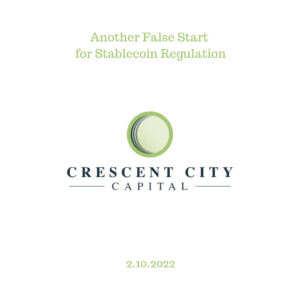Another False Start for Stablecoin Regulation
By Christopher Kilbourn | Crescent City Capital Market Analyst Intern

Steinbeck famously quipped that in America, the poor view themselves as “temporarily embarrassed millionaires.” This week, the House Financial Services Committee met to discuss the Biden Administration’s recommendations on stablecoin regulation, and the many millionaires of crypto Twitter rose up to express their dismay. Government oversight has long been the bête noire of the crypto community, and to hear the average community member rail against it, you’d think that they were the ones pulling rugs, rather than being rug pulled. Congress was similarly divided in their ideas on how to proceed with regulation, but both left and right seemed opposed to the Administration’s advice. Behind the bluster on all sides, a common conclusion can be drawn: that crypto regulation is considerably behind the times and it may take several years of increasingly large shocks to the emerging crypto banking sector before enough systemic risk is present for anything substantive to be done. Let’s see where things stand now.
In November, the Biden Administration pulled together Janet Yellen, Jerome Powell, Gary Gensler, and Rostin Benham, acting chair of the CFTC, to make policy recommendations on the regulation of stablecoins. In essence, the report their working group produced made several basic recommendations. First, that any stablecoin provider should be licensed as an insured depository institution, which it identified as a state and federally chartered bank. Second, that custodial wallet providers, i.e. any institution responsible for the wallets on which consumers store the currencies they use to make payments, should similarly be subjected to “appropriate federal oversight.”
The long and short of these requirements is that firms like not only Tether and Circle, but also Coinbase and Binance would have to register as banks and submit accordingly to the capital and risk management requirements to which banking institutions must adhere. While opponents seem to think this is a ploy to deliver decentralized finance into the hands of the existing tradfi overlords, the President’s Working Group (PWG) claims to have recommended them simply out of concern for the stability of the broader financial system. We saw last week some of the first inklings of what might occur when treasury funds are handled less than judiciously, which is a greater threat than ever in crypto protocols that increasingly involve the management of reserve assets (An update, for anyone curious.) So what’s the problem?
On Tuesday, the PWG report was finally presented to the House Financial Services Committee by Nellie Liang, the Treasury Department’s undersecretary for domestic finance, to general skepticism. Republicans appeared opposed on principle to the suggestions, arguing that limiting stablecoin issuance to chartered banks would stifle competition and rein in a new market before it was able to get off the ground. Conspicuously, a number of democrats crossed ranks to agree, with Democratic Rep. Gregory Meeks commenting, “It occurs to me that limiting stablecoin issuance to insured depository institutions, which have a high barrier to entry, could limit competition.” While a few congressional Democrats have begun to float ideas around on how legislation could be drafted in the future, it seems that there is little hope of decisive action being taken in the short term.
Reflections
One source of complication is just how quickly traditional categories break down when discussing the subject of decentralized finance. At one point, Liang specifically stated, “Stablecoin issuers do not make loans. They don’t engage in fractional reserve banking.” But clearly some stablecoin issuers do both of these things. The multi-collateral DAI stablecoin was being issued as early as 2017 as a loan secured by other cryptocurrencies, and the reserves backing USDT, the largest stablecoin by a wide margin, are comprised of only 2.9% cash. If these are activities that stablecoin issuers are engaged in, then clearly stablecoin regulation needs to regulate these activities with the same oversight and for the same reasons as they are in traditional finance.
While the crypto space widely views government crackdown as the greatest threat to the burgeoning asset class, there is an actual apocalypse in sight in the form of systemic risk brought on by unregulated activity. If protocols are issuing tokens that function identically to asset-backed securities – as Wonderland did with a token backed by yield-generating stablecoins – then they should be governed by the prudential regulations that govern traditional banking, for the exact same reasons. And if they do as Wonderland and Abracadabra did and leverage these stablecoins before investing them on other protocols, they are for all intents and purposes engaging in fractional reserve banking, and there’s no logical argument against being regulated as such. In the case of investors simply parking their own stables on a protocol in exchange for yield, there’s truly no reason they shouldn’t be covered by federal deposit insurance, at the very least.
It might not be unreasonable to say that as long as these measures go unpassed – as long as the crypto space remains free of prudential regulation – the systemic instability of the emerging crypto banking sector will remain a greater threat to investor funds than government ever could. As the space evolves into bigger and bigger business, it seems to be transitioning from a blank canvas upon which innovators and idealists experiment with the future and into a wild west in which there is very little to stop corrupt actors from operating with impunity. Until measures are put in place to prevent this, investors can always count on periodic shocks for opportunities to buy.
https://www.americanbanker.com/news/cheat-sheet-how-regulators-want-to-rein-in-stablecoins
Michael Patryn Rinsing Millions From Wonderland Treasury? (fullycrypto.com)
https://www.ft.com/content/529eb4e6-796a-4e81-8064-5967bbe3b4d9
https://www.americanbanker.com/news/lawmakers-appear-unlikely-to-limit-stablecoin-issuance-to-banks
https://www.americanbanker.com/news/democrats-circulate-bill-to-rein-in-stablecoins

